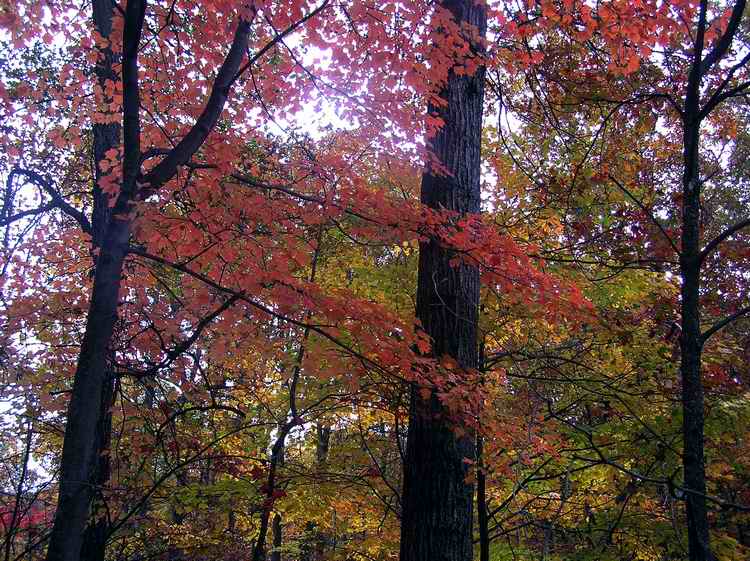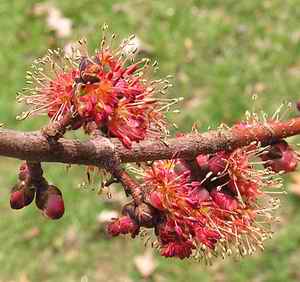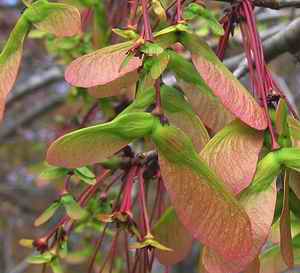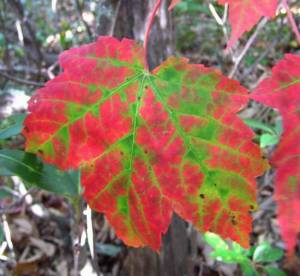
Common Name: Red Maple, scarlet maple, swamp maple, water maple, Carolina red maple, Drummond red maple – Maple is of Germanic and Norse origin, the root form is möpurr; red refers not only to the color of the leaves in the fall but to the prevalence of red in the flowers and the fruits.
Scientific Name: Acer rubrum – The most prevalent etymology for the genus name is that it is taken directly from the name of the maple tree in Latin; A more subtle derivation is that acer also means “sharp” or “cutting” in Latin, which is reference to the pointed tips of the leaves. In some texts, acer is linked to an old Germanic word for the maple tree ahorn. The species name is from ruber, the Latin word for “red.”
Potpourri: The red maple has the distinction of having the greatest north-south geographic range of any tree in eastern North America; it ranges from Newfoundland at the -40°C (which is the same as -40°F) isothermal line in the north to Florida in the south and westward to about mid-continent where it is constrained by the sere climate of the prairie. Its range is a result of its tolerance for and adaptability to diverse climates; the red maple is likely capable of growing in more soils, elevations, and moisture conditions than any other North American forest tree species. One of the primary reasons for this is that it develops root systems that reflect the prevailing conditions, deep taproots in dry areas and ramose shallow roots in wet, swampy areas. It is a major or ancillary species in 56 of the 88 forest types recognized in Eastern North America.
A second factor that contributes to the ubiquity of the red maple is reproductive adaptability. It is a polygamo-dioecious species: some trees have only male flowers; some trees have only female flowers (dioecious); some trees have both male and female flowers (monoecious) which are located on different branches and flower at different times (dichogamy) to prevent self fertilization. The flowers appear very early in the spring, several weeks before the start of vegetative twig growth.

The net result of early vernal efflorescence and sexual diversity is the production of a plethora of double samara winged seeds; a tree with a 12 inch dbh (diameter at breast height) can yield as many as a million seeds. Seed production is consistently high with some variability such that a biennial cycle of higher production is generally manifest. The samara fruits are readily wind-dispersed from April to July, and are thus an important food source for browsing animals like deer in the spring before other food sources are widely available. It is also stored by squirrels and chipmunks; rabbits eat the stump sprouts.
A third factor that contributes to the adaptability of the red maple is the facility with which the seeds germinate. They do not require any pregermination treatment such as a period of cold weather; they can begin growing immediately after they have reached maturity. Their tolerance extends to environmental conditions: they need little light and have a wide temperature and moisture range. Because of this, 75 percent of the seeds can germinate within a week with total germination rates sometimes exceeding 90 percent. The overall competitive advantage of the red maple species over other trees is borne out by field observations: there were more than 7,000 red maple seedlings six years after a clear-cut of an 8 acre oak-hickory forest in Ohio; the original plot had no red maples.

The cultural relevance of the red maple is eclipsed by the sugar maple, the latter having harder wood and sweeter sap. However the wide availability of the red maple and its fine-grained (softer) wood made it ideally suited for the manufacture of cabinetry, plates, spinning wheels, mine props, railroad ties and furniture. The bark of the red maple was used by early colonists to make dark brown and black dyes. Bark tannin was combined with iron sulphate to make writing ink. Red maple bark was used by Native Americans to make an analgesic eye wash; a tea from the bark was used for diarrhea.

But it is the brilliant autumn colors of the red maple that set it apart. It was considered Thoreau’s favorite tree. In his essay “Autumnal tints” he remarks that “It flashes out conspicuous with all the virtue and beauty of a maple – Acer rubrum. We may now read its title, or rubric, clear. Its virtues, not its sins, are as scarlet.” — and, with perhaps a touch of sarcasm “I do not see what the Puritans did at this season when the maples blaze out in scarlet. They certainly could not have worshipped in groves then. Perhaps that is why they built meeting-houses and fenced them round with horse-sheds for.”
